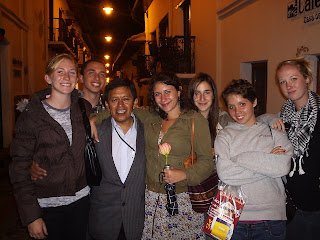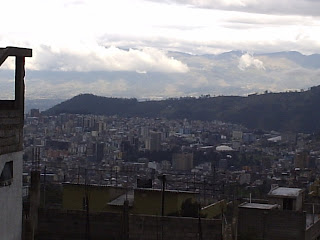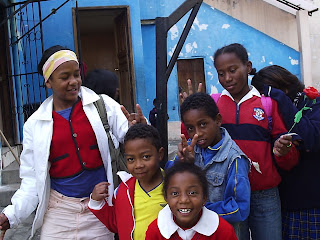Jose is quite the cool teacher. he's been teaching Kichwa for years, and knows his stuff. He jokes around with us and we really feel a strong connection to him. When he asks us, "Kanka casadochu kanki?" or, "are you married?" and we answer "Mana, nukaka mana casadochu kani." or (no, I am not married) he says "Kanka inteligentemi kani!" or "You're intelligent!" That's the type of silly humor Jose uses in class. Cool dude.
So tonight, the pres was speaking at the Presidential palace here in Quito. Jose invited us all to come and see him speak and meet him afterwards. We arrived at the presidential palace at 3pm, copies of passports in hand, and went through security.
 A cool Ecuadorian flag in the lobby of the palace
A cool Ecuadorian flag in the lobby of the palace The presidential sword. Badass.
The presidential sword. Badass. The presidential sash. It reads "My power is in the Constitution."
The presidential sash. It reads "My power is in the Constitution." Kickin it with the presidential Security
Kickin it with the presidential Security Me and my security pass for clearance into the presidential palace
Me and my security pass for clearance into the presidential palaceSo this turned out to be a press conference. Apparently he has them rather frequently, because, for two hours, he talked about his activities in the last week. Well, he went to Cuenca to discuss indigenous rights. Then he was in Quito designing "Plan Ecuador" his master plan to solve the shaky relations with Colombia and the narco trafficking that takes place on the border. He's not a great speaker, but it was still interesting to listen to him speak.
So finally, Jose introduces us to the audience. We all say "Imanalla" which means hello. Jose and the president (who speaks a decent amount of kichwa) have a little conversation. Just as he does in class, Jose is joking around with the president, in the middle of the press conference!!!
He asks the pres, how the wife is doing, how are the kids, etc... the pres, just like us, messes up a little bit but Jose gently corrects him. The pres asks what school we are from, and Jose answers "Pitzer." The pres says, with confusion, "Pizza?" The audience, also confused, looks back at us for clarification. We yell out, "Pitzer!!" again. Way to represent our school in front of the president!!
After the press conference, we go up to the podium to meet the man himself. He's pretty big dude!! I'd say, a good 6'2 210. And a nice guy as well. He asks us how we like Ecuador, how we like Jose, and how long we're here. At the same time, he was trying to leave rather early as it was his anniversary.
 The man himself.
The man himself.President Correa is a rather controversial figure as well. Nicknamed "little Chavez," (a reference to Hugo Chavez, president of Venezuela,) Correa is known for his leftist socialist policies. The rich, such as my host family, despise him. He was the architect behind the 2008 Constitution that was just ratified. Among the articles, is the legalization of gay marriage and abortion, mandatory education of Kichwa in primary school, and an extension of the presidential powers and term from 4 to 6 years....
So, after the press conference, we invite Jose out to dinner. We go to this cool little street in the Centro Historico called La Ronda. Over dinner, we discuss our trip to Maachu Pichu next week, in which Jose will be joining us. We joke about drinking Pisco Sours, the national drink of Peru, and hiking the Inca trail hungover.
 Me and Jose on La Ronda street after dinner
Me and Jose on La Ronda street after dinner The crew and Jose after dinner
The crew and Jose after dinnerSo thats my adventure with the president of Ecuador. Next chapter: Josh goes to Cuzco, Lima, and Maachu Pichu. Until then, "Kayakaman!!" (Bye!! in Kichwa)




















































